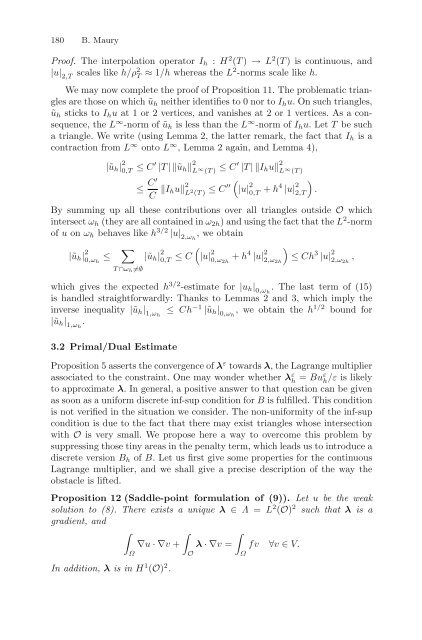Partial Differential Equations - Modelling and ... - ResearchGate
Partial Differential Equations - Modelling and ... - ResearchGate
Partial Differential Equations - Modelling and ... - ResearchGate
Create successful ePaper yourself
Turn your PDF publications into a flip-book with our unique Google optimized e-Paper software.
180 B. Maury<br />
Proof. The interpolation operator I h : H 2 (T ) → L 2 (T ) is continuous, <strong>and</strong><br />
|u| 2,T<br />
scales like h/ρ 2 T ≈ 1/h whereas the L2 -norms scale like h.<br />
We may now complete the proof of Proposition 11. The problematic triangles<br />
are those on which ũ h neither identifies to 0 nor to I h u. On such triangles,<br />
ũ h sticks to I h u at 1 or 2 vertices, <strong>and</strong> vanishes at 2 or 1 vertices. As a consequence,<br />
the L ∞ -norm of ũ h is less than the L ∞ -norm of I h u.LetT be such<br />
a triangle. We write (using Lemma 2, the latter remark, the fact that I h is a<br />
contraction from L ∞ onto L ∞ , Lemma 2 again, <strong>and</strong> Lemma 4),<br />
|ũ h | 2 0,T ≤ C′ |T |‖ũ h ‖ 2 L ∞ (T ) ≤ C′ |T |‖I h u‖ 2 L ∞<br />
( (T )<br />
)<br />
≤ C′<br />
C ‖I hu‖ 2 L 2 (T ) ≤ C′′ |u| 2 0,T + h4 |u| 2 2,T<br />
.<br />
By summing up all these contributions over all triangles outside O which<br />
intersect ω h (they are all contained in ω 2h ) <strong>and</strong> using the fact that the L 2 -norm<br />
of u on ω h behaves like h 3/2 |u| 2,ωh<br />
, we obtain<br />
|ũ h | 2 0,ω h<br />
≤ ∑<br />
(<br />
)<br />
|ũ h | 2 0,T ≤ C |u| 2 0,ω 2h<br />
+ h 4 |u| 2 2,ω 2h<br />
≤ Ch 3 |u| 2 2,ω 2h<br />
,<br />
T ∩ω h ≠∅<br />
which gives the expected h 3/2 -estimate for |u h | 0,ωh<br />
. The last term of (15)<br />
is h<strong>and</strong>led straightforwardly: Thanks to Lemmas 2 <strong>and</strong> 3, which imply the<br />
inverse inequality |ũ h | 1,ωh<br />
≤ Ch −1 |ũ h | 0,ωh<br />
, we obtain the h 1/2 bound for<br />
|ũ h | 1,ωh<br />
.<br />
3.2 Primal/Dual Estimate<br />
Proposition 5 asserts the convergence of λ ε towards λ, the Lagrange multiplier<br />
associated to the constraint. One may wonder whether λ ε h = Buε h<br />
/ε is likely<br />
to approximate λ. In general, a positive answer to that question can be given<br />
as soon as a uniform discrete inf-sup condition for B is fulfilled. This condition<br />
is not verified in the situation we consider. The non-uniformity of the inf-sup<br />
condition is due to the fact that there may exist triangles whose intersection<br />
with O is very small. We propose here a way to overcome this problem by<br />
suppressing those tiny areas in the penalty term, which leads us to introduce a<br />
discrete version B h of B. Let us first give some properties for the continuous<br />
Lagrange multiplier, <strong>and</strong> we shall give a precise description of the way the<br />
obstacle is lifted.<br />
Proposition 12 (Saddle-point formulation of (9)). Let u be the weak<br />
solution to (8). There exists a unique λ ∈ Λ = L 2 (O) 2 such that λ is a<br />
gradient, <strong>and</strong><br />
∫<br />
∫ ∫<br />
∇u ·∇v + λ ·∇v = fv ∀v ∈ V.<br />
Ω<br />
O<br />
Ω<br />
In addition, λ is in H 1 (O) 2 .
















